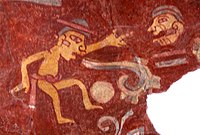
Photo from wikipedia
ABSTRACT This article investigates what is commonly called multilingual writing. Based on case studies from Mali, and drawing on a number of West African settings, it argues that in fact,… Click to show full abstract
ABSTRACT This article investigates what is commonly called multilingual writing. Based on case studies from Mali, and drawing on a number of West African settings, it argues that in fact, not all ‘multilingual’ writing is in effect multilingual. The article proposes a two-tiered classification of types of writing, based on linguistic properties of texts and the differing perspectives of writers and readers. This analysis contrasts writers’ intentions to write (in) a particular language vs. to mobilise linguistic resources in a more holistic manner. The latter type of writing, it is argued, is better characterised as language-independent, since writers do not draw borders between what can be analysed as different languages from a code-based perspective often applied by analysts. The co-existence, spaces, and potentials of language-based and language-independent writing are examined in detail. This type of writing is invisible to language planners and often taken to be unreadable, akin to the mythical writing on the wall inspiring the title of the paper. Yet, in contexts with low educational resources and great linguistic diversity, language-independent writing presents a resilient and underappreciated alternative to language-based literacies.
Journal Title: International Journal of Multilingualism
Year Published: 2020
Link to full text (if available)
Share on Social Media: Sign Up to like & get
recommendations!